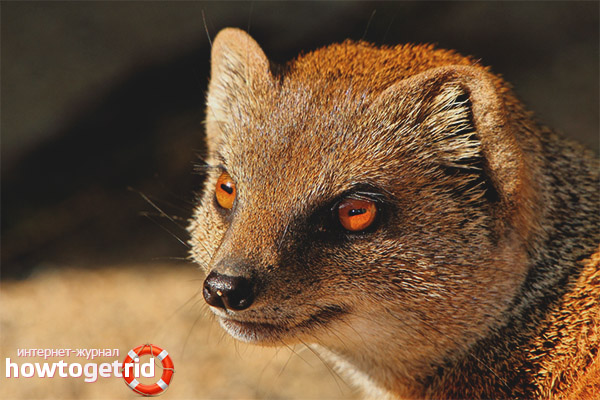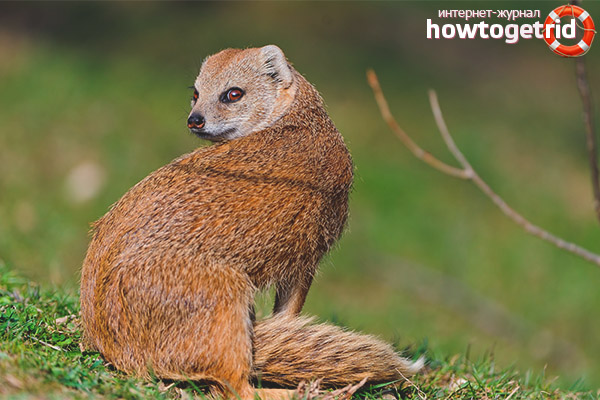The content of the article
In the mid-19th century, the English writer Rudyard Kipling wrote a fairy tale about the adventures and life of a brave and bold animal named Rikitikitavi. So the world learned about the existence of mongooses. And then, based on the tale, animated and feature films were released. What are these animals really like, how do they live, and how does a real animal differ from a fairy-tale one?
Varieties
The mongoose family is very extensive and includes 35 species. They differ (and sometimes strongly) in appearance, live in different parts of the world, but are similar in basic signs. The following breeds of mongooses can be called the most famous.
- Ordinary. The owner of gray with silver splashes of wool. It lives in Africa, India and Italy.
- Javanese. The carrier of a golden color. resident of the islands of Borneo, Sumatra and northern India.
- Striped Mungo (Zebra). An individual of brown or whitish colors, a resident of southern and central parts of Africa.
- Dwarf. The animal is gray (found also black), lives in southern and eastern Africa.
Appearance
The coat is soft and hard, so long and short. The head is not very large, the muzzle is pointed, small rounded ears are almost invisible.
The body is thin, long, from 20 to 70 centimeters. Weight also depends on the type - from five hundred grams to 6 kilograms. Short dark legs have five fingers, decorated with non-retractable claws.
The feature of mongooses is the eyes. The pupil is not located vertically, as in most mammals, but horizontally. What gives the look of the animal cunning and insight. Odor glands are located near the anus.
Habitat
Mongooses live mainly in Asian countries, Africa and southern Europe, distributed on the island of Madagascar. Some of the species people brought to America, and now animals are common on both continents.
Mongooses can live in any landscape - there are many of them in the forests of the tropical zone, and on open plains, and on hills, and even near water. The most ideal place to stay is the savannah of all kinds. It doesn’t matter if the savannah is covered with dense forbs or there are only stones there, it is flooded with rains or it is always dry there.
Lifestyle
Some species live on the earth in burrows, and more often they dig them themselves, but sometimes they settle in dwellings abandoned by other animals. Some live on land and on trees. Like most predators, they prefer a solitary lifestyle. Only females with children live in groups.
So, dwarf mongooses are held together. This species is quite small - the mass of an adult beast does not exceed 350-400 grams, so it is easier for animals to hold on to a bunch. This helps to survive and be safe while searching for food.
Meerkats with striped mongooses also try to live with relatives. To see the danger in the form of birds or land predators, they put an observer during feeding - he climbs up the hill and carefully watches the district, and noticing the danger, gives a signal.
Each mongoose has its own territory, and males have a larger size.Animals are carefully monitored so that no one invades the site.
Food
Mongooses eat any food. Although most of them like to eat insects, and they make up the lion's share of the diet (up to 80 percent), but the animals are very picky and eat everything that can be food. Small rodents, reptiles and eggs are consumed and eaten from animal food, they are eaten by all amphibians, they catch birds without ignoring bird eggs. Do not ignore plant foods - fruits, vegetables, tubers of any plants, roots and roots. Paying more tribute to fresh food, they will not disdain carrion - they will stop and eat.
Trying to find insects, mongooses carefully sniff each piece of land, sort out the leaves, examine all the cracks under the stones, taking out scorpions, beetle larvae and other animals.
Breeding
Females become sexually mature by 9 months, males - three months later. I must say that not all animals survive before the mating season.
The breeding season of each species is different and sets in differently. As soon as the mating season begins, competition begins between males. They are divided into groups, at the head of each is a leader, marking each participant with a secret that stands out from the anal glands. A leader can mate with any female. The remaining participants are divided into two types.
- Dominant. They show aggression against relatives, trying to attract the attention of the weaker sex. They themselves come in contact with the females. This type of mongoose is mainly the continuer of the genus.
- The second type - are content with the remaining females and act as educators.
After a short ritual and repeated mating, the female waits for the cubs to appear.
Preparing for childbirth, the expectant mother covers the floor of the nest with grass. Pregnancy lasts about two months. Three or four cubs are born. They are very small - no more than 20 grams, do not see or hear, but on the legs there are already sharpened claws. For several weeks they live underground, feeding on mother's milk, and in the second month they try to get out.
Parenting
Children who have got out of the hole immediately begin to eat “adult”, that is, solid, food. Their eyesight and hearing appear at the age of two weeks, so they must learn how to get food, that is, to hunt. While studying, adult mongooses feed them, sharing prey.
As soon as the young cub mongoose is 3-4 months old, he has a patron who takes care of and teaches the necessary skills suitable for life.
Content and relationship with a person
In some countries, for example, in India, these animals are bred as pets. The animals perfectly take root, getting used to home life, as they are characterized by unpretentiousness to food. The value of the animal lies in the fact that it perfectly protects the house from all kinds of snakes. And, of course, cleans the house from rats, mice and all kinds of rodents and no longer gives them a chance to resettle in the house.
Interesting Facts

It is believed that the mongoose is able to cope with any snake and, having met the reptile, enters the fray. In fact, no - a fight only happens when the animal has nowhere to go. In most cases, he chooses a simple path - turns around and runs away.
A snake bite is as deadly for a mongoose as it is for another animal. The animal does not know about the weed that serves as an antidote, and you have to rely only on speed and resourcefulness.
As already mentioned, some species of mongoose live a social life. They also hunt together. For example, meerkats living in Africa prey on snakes in small groups. They jump on the cobra and immediately jump.The snake has to constantly rise, opening the hood, which deprives her of strength and exhausts. In the end, one of the males attacks the cobra and bites the scruff up to the spine. Meerkats tear the snake to pieces.
Swiss zoologists during the research found a striking fact. The sounds that mongooses emit during communication are very similar to human language. Animals do not just squeak, but produce syllables containing both types of sounds - vowels and consonants. According to scientists, human speech during its formation was exactly the same.
Once upon a time, people were very concerned that in the Caribbean, among the plantations where precious sugar cane grew, a large number of snakes were hosted. To combat them brought mongooses. At first everything was fine, the number of reptiles was steadily decreasing. But then the mongooses began to come across rattlesnakes having a tremendous reaction, and the population of mongooses began to decrease. In general, the result was that the animals changed the object of hunting and switched to birds. And since the hens brought by man were the most numerous and accessible, people had to start a fight with mongooses.
Video: Mongoose (Herpestes)












Submit